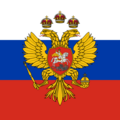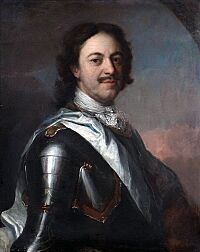Tsar of all Russia facts for kids
Quick facts for kids Tsar of all Russia |
|
|---|---|

Standard of the Tsar (c. 1693)
|
|

|
|
| Details | |
| Style | His Majesty |
| First monarch | Ivan IV |
| Last monarch | Peter I |
| Formation | 16 January 1547 |
| Abolition | 2 November 1721 |
| Appointer | Hereditary |
The Tsar of all Russia was the official title for the ruler of Russia from 1547 to 1721. During this time, Russia was known as a tsardom. This means it was a country ruled by a tsar.
The very first Russian ruler to be crowned tsar was Ivan IV. Before him, rulers were called "sovereign and grand prince." Later, in 1721, Peter I changed his title to "emperor" and declared Russia an empire. Even after this change, people still often called the emperor "tsar."
Contents
What Was the Tsar's Title?
The full title of a tsar could be very long. It changed depending on the ruler and the lands they controlled. For example, Tsar Alexis had a very long title. It listed many lands he ruled, like Great Russia, Little Russia, and White Russia. It also mentioned cities and regions like Moscow, Kiev, and Siberia. This long title showed how powerful and widespread the tsar's rule was.
How Did the Title Change?
The idea of a Russian ruler being called "tsar" grew over time.
Early Rulers and New Titles
Ivan III, a grand prince, started using the title "sovereign of all Russia." This happened after his country grew bigger and he married Sophia Palaiologina. He wanted to show that he was the rightful ruler of all former Russian lands. Ivan III also sometimes used the title "tsar" when talking with leaders from other countries.
His son, Vasily III, continued to use the title of tsar. Other European leaders, like the Holy Roman Emperor, even called Vasily III "Kayser" or "imperator." This showed they saw him as a very important ruler, similar to an emperor.
Ivan the Terrible Becomes the First Tsar
In 1533, Ivan IV became ruler when he was only three years old. On January 16, 1547, at age 16, Ivan IV was the first to be officially crowned tsar. His coronation ceremony was very grand and followed old traditions.
Other powerful leaders, like the patriarch of Constantinople, eventually agreed to Ivan IV using the title of tsar. They even compared him to a Byzantine emperor. This helped Russia gain more respect on the world stage.
Times of Trouble and New Dynasties
After Feodor I died without children in 1598, Russia went through a difficult period called the Time of Troubles. There was political chaos and even people pretending to be the rightful ruler. One such imposter, False Dmitry I, tried to claim the title of "imperator."
Eventually, the Romanov family took over from the old Rurik dynasty. The first Romanov tsar, Michael Romanov, was chosen by a special council. This meant he had to work hard to be recognized as the true ruler and tsar by other European countries. Most countries eventually accepted Michael as the ruler.
Peter the Great Becomes Emperor
Peter I wanted Russia to be seen as a major European power. He believed it was important for other countries to recognize his title as equal to an emperor. After a big victory in a war against Sweden, Peter I was urged by his advisors to accept new titles.
On November 2, 1721, Peter I officially adopted the title of emperor. He was also given the titles "Father of the Fatherland" and "All-Russian Emperor." This marked the end of the "tsar" as the official highest title and the start of the Russian Empire.
List of Tsars
Here is a list of the main tsars who ruled Russia:
| Name | Lifespan | Reign start | Reign end | Notes | Family | Image |
|---|---|---|---|---|---|---|
Ivan IV
|
25 August 1530 – 28 March 1584 |
26 January 1547 | 28 March 1584 | Son of Vasily III and Elena Glinskaya | Rurik |  |
Feodor I
|
31 May 1557 – 17 January 1598 |
28 March 1584 | 17 January 1598 | Son of Ivan IV and Anastasia Zakharyina-Yuryeva | Rurik |  |
Boris
|
1551 – 13 April 1605 |
21 February 1598 | 13 April 1605 | Brother-in-law of Feodor I Elected by Zemsky Sobor |
Godunov |  |
Feodor II
|
1589 – 20 June 1605 |
13 April 1605 | 10 June 1605 | Son of Boris Godunov and Maria Grigorievna Skuratova-Belskaya Murdered |
Godunov |  |
False Dmitry I
|
1581 – 17 May 1606 |
20 June 1605 | 17 May 1606 | Claimed to be son of Ivan IV Murdered |
Rurik (claimed) |
 |
Vasily IV
|
22 September 1552 – 12 September 1612 |
19 May 1606 | 17 July 1610 | Orchestrated a conspiracy against False Dmitry, proclaimed Tsar by the nobles and later desposed
Pretender: False Dmitry II (since June 1607) |
Shuysky |  |
Michael
|
12 July 1596 – 12 July 1645 |
26 July 1613 | 12 July 1645 | Founder of Romanov Dynasty First cousin once removed of Feodor I Co-ruler: Patriarch Filaret (1619–1633) |
Romanov |  |
Alexis
|
9 May 1629 – 29 January 1676 |
12 July 1645 | 29 January 1676 | Son of Michael and Eudoxia Streshneva | Romanov |  |
Feodor III
|
9 June 1661 – 7 May 1682 |
29 January 1676 | 7 May 1682 | Son of Alexis and Maria Miloslavskaya | Romanov |  |
Ivan V
|
6 September 1666 – 8 February 1696 |
7 May 1682 | 8 February 1696 | Son of Alexis and Maria Miloslavskaya Younger brother of Feodor III and Sophia Elder half-brother of Peter I Co-ruler: Peter I Regent: princess Sophia (8 June 1682 – 17 September 1689) |
Romanov |  |
Peter I
|
9 June 1672 – 8 February 1725 |
7 May 1682 | 2 November 1721 | Son of Alexis and Natalya Naryshkina Younger half-brother of Feodor III Co-ruler: Ivan V (7 May 1682 – 8 February 1696) Regent: Natalya Naryshkina (7 May – 2 June 1682), Sophia Alekseyevna (8 June 1682 – 17 September 1689) |
Romanov |  |
See also
- List of Russian monarchs
- Grand Prince of Vladimir
- Prince of Moscow
- Emperor of Russia

